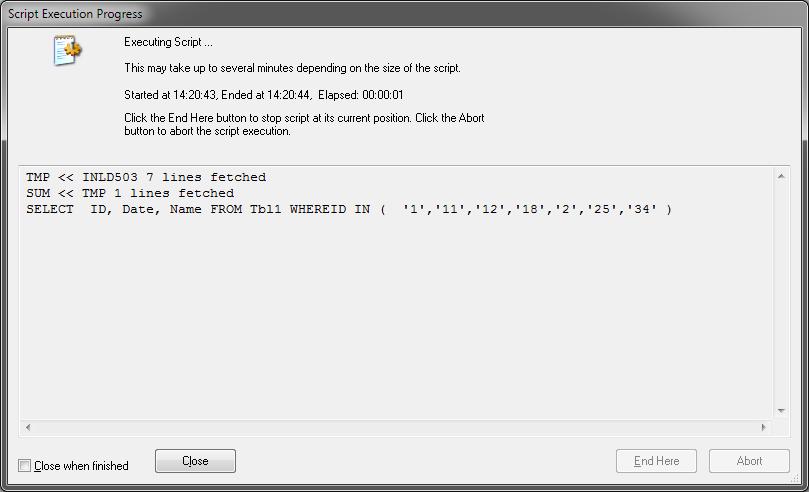Unlock a world of possibilities! Login now and discover the exclusive benefits awaiting you.
- Qlik Community
- :
- All Forums
- :
- QlikView App Dev
- :
- Re: Use data from resident load in SQL query
- Subscribe to RSS Feed
- Mark Topic as New
- Mark Topic as Read
- Float this Topic for Current User
- Bookmark
- Subscribe
- Mute
- Printer Friendly Page
- Mark as New
- Bookmark
- Subscribe
- Mute
- Subscribe to RSS Feed
- Permalink
- Report Inappropriate Content
Use data from resident load in SQL query
Hello
Can someone direct me on how to use a resident load as part of an IN statement in an SQL where clause?
I have a primary key that is populated in a load statement that I wan to utilize in the where statement of an sql query.
Here is an example of the script:
IDSTG:
LOAD ID
FROM excelsheet; //contains 500 ID values
LET vID = PEEK('ID','IDSTG');
DEMO:
LOAD DISTINCT *;
SQL
SELECT ID, Date, Name
FROM Tbl1
WHERE ID IN ('$(vID)')
I want to use vID like it is a temp table that can be referenced in the SQL script.
Accepted Solutions
- Mark as New
- Bookmark
- Subscribe
- Mute
- Subscribe to RSS Feed
- Permalink
- Report Inappropriate Content
Hi Andrew
1 exm:
TMP:
LOAD * Inline
[
ID,FIELD
1,A
2,C
11,V
34,N
25,U
12,P
18,O
];
;
[SUM]: LOAD Concat(CHR(39) & ID & CHR(39),',') AS ID Resident TMP;
LET v_IN_ID = trim(Peek('ID'));
DROP Table TMP, SUM;
TRACE SELECT ID, Date, Name FROM Tbl1 WHEREID IN ( $(v_IN_ID) );

- Mark as New
- Bookmark
- Subscribe
- Mute
- Subscribe to RSS Feed
- Permalink
- Report Inappropriate Content
You can use where exists for this rather than IN clause.
- Mark as New
- Bookmark
- Subscribe
- Mute
- Subscribe to RSS Feed
- Permalink
- Report Inappropriate Content
This ways
IDSTG:
LOAD
ID as IDloading
FROM excelsheet; //contains 500 ID values
DEMO:
LOAD DISTINCT *
WHERE Exists( IDloading,ID )
SQL
SELECT ID, Date, Name
FROM Tbl1;
- Mark as New
- Bookmark
- Subscribe
- Mute
- Subscribe to RSS Feed
- Permalink
- Report Inappropriate Content
Won't this method still pull everything from the SQL query then apply the WHERE Exists afterwards?
Tbl1 is a large table that take a lot of time to query against.
- Mark as New
- Bookmark
- Subscribe
- Mute
- Subscribe to RSS Feed
- Permalink
- Report Inappropriate Content
Hi Andrew
1 exm:
TMP:
LOAD * Inline
[
ID,FIELD
1,A
2,C
11,V
34,N
25,U
12,P
18,O
];
;
[SUM]: LOAD Concat(CHR(39) & ID & CHR(39),',') AS ID Resident TMP;
LET v_IN_ID = trim(Peek('ID'));
DROP Table TMP, SUM;
TRACE SELECT ID, Date, Name FROM Tbl1 WHEREID IN ( $(v_IN_ID) );

- Mark as New
- Bookmark
- Subscribe
- Mute
- Subscribe to RSS Feed
- Permalink
- Report Inappropriate Content
That appears to do the trick. Thanks much!
- Mark as New
- Bookmark
- Subscribe
- Mute
- Subscribe to RSS Feed
- Permalink
- Report Inappropriate Content
NO it is also a good technic to load data from selected ids where you can load the data on the SQL tables it self.
- Mark as New
- Bookmark
- Subscribe
- Mute
- Subscribe to RSS Feed
- Permalink
- Report Inappropriate Content
It appears to be pulling everything then applying the Where exists afterwards as I can see in the Script Execution Process the number of lines fetched when executing the SQL portion is higher than the number of IDs. Also, I do not have access to write to tables in that SQL server thus is why I needed to figure out how to apply the IDs I needed only.
- Mark as New
- Bookmark
- Subscribe
- Mute
- Subscribe to RSS Feed
- Permalink
- Report Inappropriate Content
So this solution only seems to work if the list of values in the IN Statement is less than 1000. If you have more than 1000 values the sql errors out. Is there anyway around this limit?